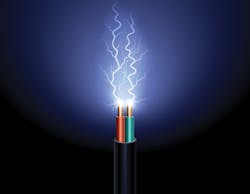The following misunderstandings often lead to trouble and can lead to death, says Bob LoMastro, president of LoMastro & Associates Inc., Mundelein, IL. LoMastro draws upon a career spanning more than 40 years of teaching on safety- and health-related topics. He has developed a wide variety of electrical safety programs for OSHA and the National Fire Protection Association.
Myth No. 4. Electricity will always take the path of least resistance. This bit of myth has gotten many people hurt. It goes along with the previous myths about grounds keeping one safe. Grounds are designed primarily to protect the system from lighting strikes and overloading that can result in fires.
So here’s the whole story. Electricity (or current) travels from a high potential (voltage) to any lower potential that completes the circuit. The electrons in an atom can be influenced to leave the orbit of an atom by the application of voltage (pressure). In order for the current to flow, the missing electron has to be replaced. The wiring of an electrical circuit provides a path of atoms to the equipment through the hot wire (officially called the ungrounded conductor) and back through the neutral wire (officially called the grounded conductor). That is a complete circuit. It’s completely safe as long as everything works as planned. However, when the plan goes wrong and current (electrons in motion) finds another way to get home (the source of the voltage), it will take a detour. In other words, current will take every path that allows it to complete its circuit.
Consider this scenario. You are touching a grounded electrical tool when something breaks and causes the hot wire to contact a metal part. The metal parts are connected to the ground wire. A new path has been provided for the current and it rushes through the ground wire, which connects to the neutral wire and the earth, back at the service panel. The ground wire’s function is to allow a large amount of current to flow, which should overheat the fuse or circuit breaker.
That would seem like an ideal plan if you weren’t holding on to the same metal part that is connected to the ground wire. The human body is about 60% water and more than 85% mineral in solution. Humans conduct electricity nearly as well as aluminum. Remember the first myth (It takes a lot of voltage to kill), which states that it takes only about 100 milliamps (mA) to kill a human (1 milliamp = 1/1000 of an amp). It takes over 20,000 mA to trip a 20-amp breaker, so if even 1% of the current in this scenario takes the path you provide from the tool to the earth and touches your heart for a fraction of a second, the game is over.
That is why electricians were always taught (before the availability of dielectric gloves) to use one hand in an electrical panel. If they touched a live part while their other hand contacted something grounded, the current is directed through the heart and lungs. This is also why it is so important that whenever we work near electrical circuits we wear insulated hard hats.
Human skin offers some resistance to current flow when it is dry, but nearly zero resistance when it is wet. That brings us to our next myth:
Myth No. 5. Water will short out an electrical circuit. Water is H2O. Hydrogen is not a conductive element, and neither is oxygen (the 2 isn’t conductive either). It is the impurities in water that provide a path for electricity. Unless you have tested the water for impurities, you must assume that they are there. The more water that is present, the more the current is dissipated or spread out. The higher the mineral content, the better it acts as a conductor. As more of your body contacts the water, more of the current will flow through you. There are just too many variables in this game for you to want to play. If your basement floods or your electrical tools get wet, you don’t want to touch anything until the power has been safely shut down!
Myth No. 6. I’ll be safe if I touch only one wire. This bit of non-wisdom has a grain of truth, if you know exactly what each wire is connected to, and there aren’t any unknown factors. However, people assume too often that they know more than they actually do. You can touch a non-energized ground or neutral and not feel a thing. There has to be a path between two potentials for a current flow. Before you touch anything, you have to know the proper way to test and take nothing for granted. People miswire electrical systems all the time.
For example, a neutral wire (the grounded one) should be white or off-white. At the service entry, it is connected to the ground wire, which should be green or bare. The neutral returns the current to the source, but because it’s grounded the voltage should be near zero. The hot wire can be any color other than white or green. It supplies the power from the source. Unfortunately, people often use green as the hot or black as the ground. They either don’t know any better or follow the “it was all I had” technique.
Now let’s get to the truth, as stated in Myth No. 1-It takes a lot of voltage to kill: It’s the current that causes you pain. But there needs to be voltage for current or electrons to flow. If you touch a hot wire, and the current can find its way through you and get back to the source, you start doing the “110 tango.” The white wire or neutral is grounded and should not have any voltage, just current. But if Helpful Hank used the white wire as a hot, start dancing. Or maybe Hank switched the wires when he connected your receptacle. So now you have voltage on the neutral side of your equipment and the music starts.
The correct wiring of receptacles and switches is as important as proper color-coding. Know your limitations. Testing equipment requires knowledge and discipline to use properly. Mistakes with meters can result in serious burns, electrical shocks, and arc blasts.
Myth No. 7. If you can’t see a wound, don’t worry. Electricity can burn from the outside in and from the inside out. Damage can be on the surface of the skin, beneath the skin, or both. If you touched an energized conductor and it hurt, go to the emergency room. Serious injury to nerves and blood vessels cannot always be felt. People die days after an electrical injury from internal bleeding they never even suspected.(This is the second in a two-part series. Part 1 can be found here.)



